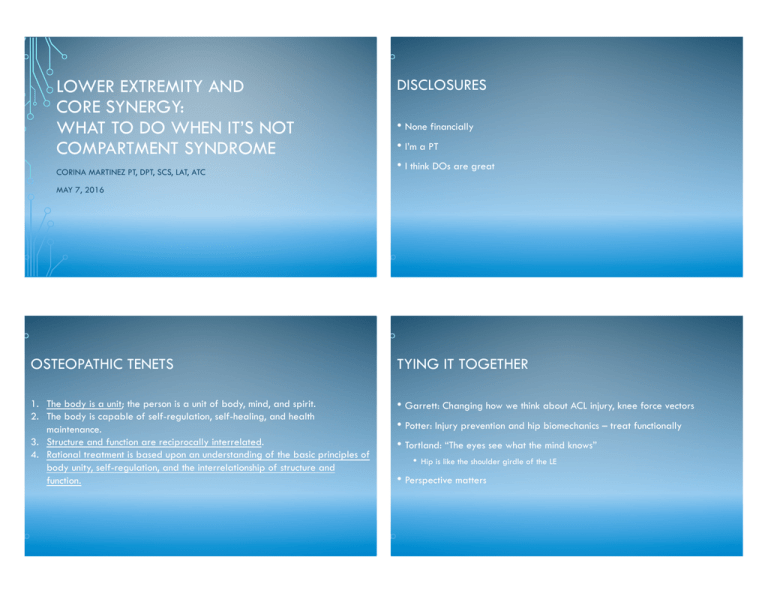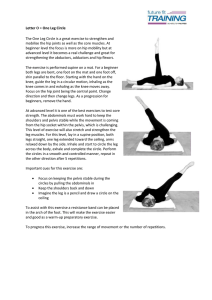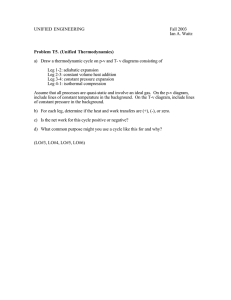LOWER EXTREMITY AND CORE SYNERGY: WHAT TO DO WHEN
advertisement

LOWER EXTREMITY AND CORE SYNERGY: WHAT TO DO WHEN IT’S NOT COMPARTMENT SYNDROME CORINA MARTINEZ PT, DPT, SCS, LAT, ATC DISCLOSURES • None financially • I’m a PT • I think DOs are great MAY 7, 2016 OSTEOPATHIC TENETS TYING IT TOGETHER 1. The body is a unit; the person is a unit of body, mind, and spirit. 2. The body is capable of self-regulation, self-healing, and health maintenance. 3. Structure and function are reciprocally interrelated. 4. Rational treatment is based upon an understanding of the basic principles of body unity, self-regulation, and the interrelationship of structure and function. • Garrett: Changing how we think about ACL injury, knee force vectors • Potter: Injury prevention and hip biomechanics – treat functionally • Tortland: “The eyes see what the mind knows” • Hip is like the shoulder girdle of the LE • Perspective matters OBJECTIVES EPIDEMIOLOGY OF SHIN PAIN • Epidemiology • Not much in literature, possibly due to non-reporting since people stop activity • Clinical Presentation • Differential Diagnosis • MTSS 10-15% of running injuries, 60% of leg pain syndromes • CECS incidence 14-33%, 2nd most common cause of exertional leg pain • Diagnostic Imaging/Tests • Anatomy and Biomechanics Review • Males and females affected equally • Alternative Treatment Options CLINICAL PRESENTATION • Runners and jumpers - often endurance athletes • Onset of pain with activity, time to onset variable by individual • Pain relief with rest, but returns upon resuming activity • May present with numbness/tingling as well as pain IT’S POLL TIME!!!! DIFFERENTIAL DIAGNOSIS DIAGNOSTIC IMAGING/TESTING • Chronic exertional compartment syndrome • MTSS • Posterior tibialis tendinopathy • Popliteal artery entrapment • Stress reaction or stress fracture • Sural nerve entrapment • Lumbar radiculopathy • MRI arteriogram ANATOMY REVIEW • X-ray • Diagnostic MSK US • Compartment Pressure testing • Bone scan • Doppler US COMPARTMENTS OF THE LOWER LEG SUPERFICIAL POSTERIOR ANTERIOR LATERAL • Ligaments – interosseous membrane • Nerves – common fibular, tibial, sural, saphenous Tibialis anterior Peroneus longus Gastrocnemius Tibialis posterior Extensor hallucis longus Peroneus brevis Plantaris Flexor hallucis longus Extensor digitorum longus N/V: superficial peroneal n Soleus Flexor digitorum longus • Vascular – popliteal artery • Muscles – 13 of them Peroneus tertius N/V: sural n Popliteus • Bones – tibia and fibula N/V: deep peroneal n, anterior tibial vessels DEEP POSTERIOR N/V: tibial n, posterior tibial vessels LOWER LEG MUSCLE FUNCTION BIOMECHANICS REVIEW • To control movement at the ankle and foot (and sometimes the knee) • Movement follows the path of least resistance • Primary and secondary movers allow body to achieve • So why are we asking those muscles to also control our body in space during running and jumping? desired motion • May not be most efficient movement pattern • What muscles extend hip? • Literally at the bottom of the totem pole • STRUCTURE AND FUNCTION ARE RECIPROCALLY INTERRELATED • Closed vs open chain movement GET UP! STAND UP! BIOMECHANICAL SCREEN • 1. Squat • Important to identify which muscles groups are being utilized during movement • Double leg squat: targets glutes, quadriceps • 2. Balance on one leg • 3. Balance on the other leg • 4. Mini-squat R • 5. Mini-squat L • Open chain to isolate muscle activation • Closed chain to utilize muscles functionally • common mistakes: use back, shins, over-utilize quads causing knee pain • Single leg balance: hip strategy vs ankle strategy • Easier to start stabilized over base of support vs trying to recover and pull back to center • Single leg squat: indicative of running mechanics • look for anterior or medial knee movement, increased dorsiflexion, poor trunk control • If poor control, consider that they are repeating poor movement pattern every step during run PHYSICAL THERAPY FOR SHIN PAIN FIND THE CAUSE • Typical treatments include: • Challenge is to find why the shin muscles are being over-used • THE BODY IS A UNIT • History and clinical exam • Assess muscle strength, activation, and timing with manual muscle testing • Assess dynamic strength and activation with biomechanical testing • Can the patient properly recruit core and gluteal muscles to efficiently perform • Modalities for pain management • STM • Stretching • Ankle/Calf strengthening?!?! • LET’S THINK ABOUT THIS! Treating overuse injury by using it even more? • Rational treatment is based upon an understanding of the basic principles of body unity, self-regulation, and the interrelationship of structure and function. running motion? CASE REPORT OBJECTIVE FINDINGS • 25 y/o female distance runner • Pain rating 7/10 • Decreased muscle activation for glute max, glute med, TFL • Increased activation of back and hamstring muscles • Difficulty with core stabilization • Normal strength with ankle manual muscle testing • Normal flexibility • Normal LE alignment • History of bilateral lower leg pain for 8 months • Goal to run Marine Corps marathon in 8 weeks • Planned to do race with or without pain • Pain, swelling, numbness/tingling in bilateral feet 1 mile into runs; 30 mi/wk • Symptoms resolve with rest and ice within 1 hour COMPARTMENT PRESSURE TESTING OBJECTIVE FINDINGS • Squat mechanics – hip internal rotation, pain in knee and shins with motion • Single leg balance – Fair balance bilaterally, but ankle strategy vs hip strategy • Single leg squat – Increased hip IR, anterior and medial knee translation, decreased trunk stability • *mimics landing mechanics during running CORE MUSCULATURE EXTERNAL OBLIQUES CORE MUSCULATURE INTERNAL OBLIQUES RECTUS ABDOMINIS TRANSVERSE ABDOMINIS INTERVENTIONS • TrA contractions ! stabilization – BREATHING! • Manual treatment to lower leg muscles • Activation vs Strengthening • Hip rotators, abductors, extensors • Functional movement patterns • Controlled sit to stand, eccentric hip control • Balance activities • Must demonstrate ability to control body over leg with single leg squat • Usually gradual return to running progression with walk/jog increments OUTCOMES • Patient relocated for work, but continued with strengthening program • Completed Marine Corps marathon with no numbness until 21 miles • 1 month later completed Spartan Beast race (12+ miles, 30+ obstacles) • UPDATE: • Recently ran half marathon without any symptoms • Plans to run Chicago half marathon in October QUESTIONS? TAKE HOME POINTS Thank you. corina.martinez@duke.edu • If continued lower leg pain and all differential dx cleared, consider looking at body as unit and assessing movement biomechanics • Just because they can do the move doesn’t mean that they are doing it correctly OR Perfect practice makes perfect • Lower leg pain is often the result of ”lazy butt syndrome” • Find a PT friend! MARINE CORPS MARATHON SPARTAN BEAST 12+ miles, 30 obstacles REFERENCES • Reinking M. Exercise Related Leg Pain (ERLP): a Review of The Literature. N Am J Sports Phys Ther. 2007 Aug; 2(3): 170–180. • Anuar K, Gurumoorthy P. Systematic review of the management of chronic compartment syndrome in the lower leg. Physiotherapy Singapore. 2006; 9:2-15.


